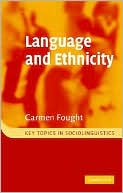

 |

|

Sold Out
Book Categories |
Preface xi
Acknowledgments xiv
General issues in ethnicity and language
What is ethnicity? 3
Areas of agreement about ethnicity 4
Possible definitions of ethnicity 8
Possible definitions of race 9
Discussion questions 17
Suggestions for further reading 18
Language and the construction of ethnic identity 19
What linguistic resources do individuals have in constructing identity? 21
Indexing multiple identities 23
Ethnic pride or assimilation? 27
How is an individual's ethnicity co-constructed by the community? 30
Language and the construction of ethnic identity: three individual cases 33
Discussion questions 40
Suggestions for further reading 41
Linguistic features and ethnicity in specific groups
African-American groups 45
What is AAVE? 46
AAVE grammar 47
AAVE phonology 49
Variation in the use of non-standard features in AAVE 51
Attitudes towards AAVE 53
Regional variation in AAVE: is AAVE converging toward a supraregional norm? 56
Another possibility: a blendof supraregional and regional norms 60
Standard AAE and the language of middle-class African-Americans 62
AAVE in the media 66
Discussion questions 68
Suggestions for further reading 68
Latino groups 70
The complexities of identity in Latino communities 71
Repertoires: multiple codes for multiple identities 73
Attitudes, choices, and the construction of identity 75
The structure of dialects in latino communities 79
Chicano English phonology 80
Chicano English grammar 82
The structure of other Latino English dialects 84
Latino dialects of Spanish 86
The language gap: differences among generations 87
Discussion questions 87
Suggestions for further reading 88
Linguistic variation in other multiethnic settings 89
Cajuns and Creoles in Louisiana 90
South African ethnic groups 96
Maoris in New Zealand 105
Discussion questions 109
Suggestions for further reading 110
Are white people ethnic? Whiteness, dominance, and ethnicity 112
The social correlates of being white 115
The linguistic correlates of being white 117
The consequences of "sounding white" 119
Humor and the portrayal of "whiteness" 121
Discussion questions 131
Suggestions for further reading 131
Dialect contact, ethnicity, and language change 133
Dialect contact and ethnic boundaries 133
Influences of minority ethnic dialects on the dominant dialect 139
Contact among ethnic minority dialects 141
Ethnic minority group speakers and sound change 143
Discussion questions 150
Suggestions for further reading 150
The role of language use in ethnicity
Discourse features, pragmatics, and ethnicity 155
Indirectness 156
Turn-taking, silence, and backchanneling 160
Joking 164
Complimenting 166
Acquisition of language norms 168
Discussion questions 170
Suggestions for further reading 170
Interethnic communication and language prejudice 172
Tennis, anyone? 172
Interethnic communication 174
Differences in language use norms in public settings 175
Language varieties and interactional styles in the classroom 181
Teaching a standard variety to speakers of vernacular varieties 184
Accent hallucination 187
Matched guise studies and linguistic profiling 189
Discussion questions 195
Suggestions for further reading 195
Crossing: may I borrow your ethnicity? 197
Classic studies of crossing in the UK 199
Who crosses? 200
Why does a speaker cross? 202
How does an individual get access to a linguistic code other than his or her own? 204
How extensive is crossing, linguistically? What linguistic areas are individuals who cross most likely to use? 206
Does crossing lead to less racism? 209
Crossing versus passing 211
Discussion questions 214
Suggestions for further reading 215
Notes 216
Glossary of terms 218
References 228
Index 243
Login|Complaints|Blog|Games|Digital Media|Souls|Obituary|Contact Us|FAQ
CAN'T FIND WHAT YOU'RE LOOKING FOR? CLICK HERE!!! X
 You must be logged in to add to WishlistX
 This item is in your Wish ListX
 This item is in your CollectionLanguage and Ethnicity
X
 This Item is in Your InventoryLanguage and Ethnicity
X
 You must be logged in to review the productsX
 X
 X

Add Language and Ethnicity, , Language and Ethnicity to the inventory that you are selling on WonderClubX
 X

Add Language and Ethnicity, , Language and Ethnicity to your collection on WonderClub |